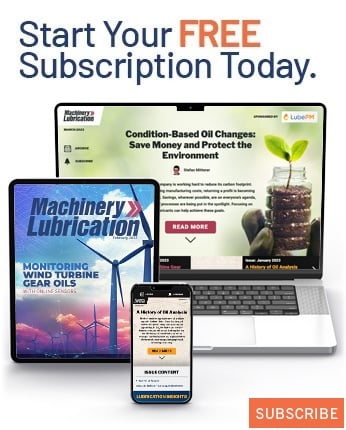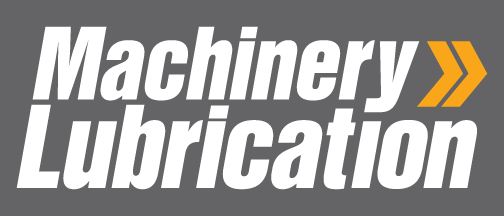
Company Overview
VLI is a company that has been in the market for over 10 years. We work with general logistics, like grain transport, siderurgy products, fertilizers, etc. VLI is an industrial unit that owns five ports and nine warehouses and has a large quantity of equipment (reductors, bearings, electric engines, etc.). It requires constant maintenance, including mechanics, structure, and lubrication processes.
Before, the port and warehouse maintenance used to be just corrective. The budget was spent on failure and repair, and time was used to correct mistakes instead of being used to monitor and improve processes. However, in just four years, VLI was able to implement a reliable lubrication program that raised the port unit initial ASCEND™ assessment score from 24% to 90%. The main steps will be presented here to explain how this remarkable evolution was possible.
Introduction
Reliable lubrication is essential to ensure the efficient and long-lasting performance of machines and equipment. It involves using suitable lubricants and correct application to reduce friction and wear, prevent corrosion, and maintain the proper functioning of mechanical components.
Reliable lubrication not only extends the life of equipment but also helps prevent unexpected failures, thus minimizing maintenance costs and increasing productivity. In this context, carefully choosing lubricants and implementing effective lubrication practices are fundamental to ensuring efficient and safe industrial operations.
From that, the main phases of the project can be seen below:
- Defining the engineer responsible for corporate project management.
- Defining the local project manager responsible for the project at each site.
- Diagnosing and evaluating the processes involving lubrication.
- Obtain all information about the equipment and elaborate on the lubrication plan.
- Teaching all employees involved in the lubrication program.
- Elaborating on the regulations and corporate standards, from the lubricant selection to its disposal.
- Follow up on the lubrication maturity development monthly.
A target was established based on the first score obtained in 2020 of 24%. The unit had a period of just over a year until the next lubrication maturity diagnosis to achieve this objective, implementing best practices.
From this, the methodology is guided by the following topics: selection of lubricants, reception and storage, handling and application, contamination control, oil monitoring and analysis, environment, ecological disposal, and energy efficiency.
The implemented practices will be addressed in this article, and the main indicators related to the project will be presented.
Development
1. Training
People trained in lubrication play a fundamental role in the maintenance of machines and equipment. They ensure that lubrication systems are properly managed, which extends equipment life, reduces maintenance costs, and increases operational efficiency.
One of the first project learnings: “It’s necessary to provide knowledge to people. They don’t know that they don’t know.” Due to this affirmation, the first project action was training people directly involved with lubrication.
Since 2018, an average of 70 employees for Level 1 capacitation have been trained: machine lubricant technician and machine lubricant analyst. Besides, the Level 2 training is also defined annually by following the training matrix according to the company's lubrication policy.
Based on the corporate lubrication policy, a matrix of training and certifications is followed for each unit of the company. The VLI - Vitória unit stood out by managing to certify 100% of the lubrication team, including maintenance leaders, analysts, and performers.

Another important learning lesson is that it's necessary to train and involve all the maintenance, operation, and industrial cleaning teams, at least in lubrication fundamentals. They don't work with lubrication directly but live with the machines daily.
An equipment intervention usually made by a mechanic, like a motor removal from a gear motor, can result in oil contamination if he doesn't take basic care. A bearing cleaning activity, done in the wrong way, can condemn the grease inside. If you put lubrication items on the route inspector's checklist, you gain a significant partner in identifying problems.
2. Leadership Involvement
At VLI, all the maintenance managers and supervisors were trained in MLT1. Putting leadership inside a classroom for four days for technical training with an exam at the end is not common. But it was very powerful and assertive. It worked like an immersion in lubrication, and much more important than passing the exam, it changed their minds about how important and critical this process is for the business run by them in the plants.
Besides training, another vital action related to leadership was to turn lubrication into part of the Maintenance Leadership Committee through a lubrication subcommittee. This meant having two leaders directly linked to the subcommittee and having lubrication as a topic discussed bi-monthly among all managers and general managers.
Giving them knowledge and showing them the work in progress resulted in receiving their support. And it was imperative for the project's evolution. The VLI - Vitória plant was recognized for receiving the greatest support from the leader and the one that showed the most significant evolution in maturity. This indicator represents the importance of training the entire team involved in the process.
3. Lubricant Supplier Selection
Having a lubricant supplier offers a series of benefits for industrial operations. Firstly, it ensures consistency in the lubricant quality, which is essential to maintain equipment performance and reliability.
Furthermore, by working with a single supplier, it is possible to establish a solid and collaborative relationship, resulting in better commercial conditions, specialized technical support, and personalized services according to the company's needs. Another important point is the simplification of inventory and logistics management, as there is a reduction in the variety of products to be monitored and stored.
Finally, a dedicated supplier can offer training and education programs for maintenance staff, ensuring they can use lubricants effectively and maximize the benefits to the equipment. The objective here was to structure the purchasing process to have quality products delivered in an acceptable time and a concrete technical support program to help us with decisions –consolidation, changes, and optimization – and on studies and problem solutions.
LVI worked to evaluate three parameters in particular when it came to selecting a lubricant supplier—product, service, and logistics.
3.1 Product
Grading technical parameters by performance importance, we eliminated suppliers that didn't meet the minimum product requirements. With the ones who met those minimum requirements – as viscosity index, four ball, Timken, foam test, and others – we did a quantitative ranking after giving weight and score for each parameter and product. This helped identify which products were most suitable for our applications.
3.2 Service
In the contract technical specification, we listed four necessary service groups beyond the lubricant supply itself.
- Technical Support: Engineering support, especially for choosing the best lubricant for each application, product changes, and consolidation.
- Failure analysis support: In case of lubrication failure, an expert helps to find the root cause.
- Problems solution: If the lubricant is considered the root cause of the problem, the supplier must help find the solution (for example, change a type of lubricant or an additive package).
- Laboratory analysis: They have their own laboratory and make the same retests or punctual analyses to confirm product composition.
3.3 Logistics
This third parameter is crucial for VLI due to the plants' distribution throughout the country. There are sites more than 2,000 km apart. Therefore, our supplier must have a good distribution structure and logistical plan to supply products within an acceptable timeframe.
We defined two logistic parameters:
- Delivery time: maximum 10 days for any plant.
- Logistic structure: at least one distribution center for each Brazilian region where VLI has ports or warehouses.
4. Lubrication Room
That's an important investment. It is the first care with the lubricant, where it will be waiting and prepared for use. The plant received the investment to build up the lubricant room following all minimum requisites defined by the corporate policy. This included a closed space with:
- Solid walls and ceiling
- An air-conditioning system
- Sealed floor
- Containment dike (dimensioned for the lubricant volume)
- Firefighting equipment.
Everything is always extremely clean.

Before and After: Lubrication Room
The VLI - Vitória unit structured a complete lubrication room, with storage tanks equipped with filters and breathers to clean the lubricant before its application, a little field laboratory to make initial oil analyses, cabinets for the application equipment and spare parts, and a complete Key Performance Indicator (KPI) visual management.
5. Method of Execution and Application
Handling and applying lubricants using accessories and good practices can significantly improve efficiency and safety. Here are some applied patterns:
- Use appropriate tools: Use accessories such as grease guns, lubrication pumps, and automated distribution systems to ensure precise and uniform application of lubricants.
- Pre-cleaning: Before applying the lubricant, make sure the surfaces are clean and free from dirt and residue. This helps prevent lubricant contamination and improves lubrication effectiveness.
- Correct amount: Use flow meters and regulators to ensure that the right amount of lubricant is applied to each lubrication point. This avoids waste and provides adequate lubrication.
- Apply at the correct temperature: Some lubricants require specific temperatures for effective application. Make sure the lubricant is at the correct temperature before applying it.
- Regular maintenance of accessories: Keep lubrication accessories clean and in good working order. Perform periodic inspections and replace worn parts to ensure consistent performance.
- Team training: Ensure that the team responsible for applying lubricants is properly trained in best handling and application practices. This includes correct use of accessories, safety procedures, and preventative maintenance.
- Documentation and traceability: Keep detailed records of lubrication activities, including the types of lubricants used, quantities applied, and lubrication intervals. This helps ensure compliance with maintenance requirements and makes it easier to identify potential problems.
By following these good practices and using the appropriate accessories, it is possible to guarantee an effective and safe application of lubricants, contributing to the equipment's extended useful life and optimized performance.
.jpeg)
Accessories and Application Devices
6. Contaminant Removal and Exclusion
The purpose of implementing good practices for lubricant contamination control is to create a solid strategy to guarantee the quality and integrity of oils and greases installed in equipment through the exclusion and removal of contaminants, ensuring greater longevity of installed lubricants and elimination of the main root causes of failures of lubricated components, directly adding reliability to productive assets.

Phases Implemented in the Contamination Control Program
To guarantee the Success of the Program and the Projected Results, 03 main phases were structured:
- Defining the contamination control strategy based on the criticality of the equipment and costs.
- Defining what type of accessory will be installed on each equipment, according to criticality.

Improvements to Already-Installed Accessories
In the first image with galvanized steel, the shielding oxidized quickly in the area where fertilizer products were operated. As an improvement, the accessories were replaced with stainless steel parts, keeping the parts more durable and reducing the entry of contaminants.
Thus, cleaning objectives were defined by the type of equipment, using recommendations from the manufacturer's manuals and the experience of the professionals. Furthermore, decisions and modifications should be aligned with predictive maintenance. It is crucial as it changes alarm limits, trend lines, and even the sampling method or condition.
7. Proactive and Predictive Maintenance
A proactive oil analysis program is essential for the early identification of wear, contamination, or failure issues in industrial equipment. This allows corrections to be made before significant damage occurs, increasing equipment reliability, minimizing unplanned downtime, and reducing maintenance costs. Regular monitoring of lubricating oil also contributes to optimizing oil change intervals and improving equipment energy efficiency.
Furthermore, a consistent analysis program allows for oil change interval optimization, avoiding unnecessary changes and reducing maintenance costs. It also contributes to energy efficiency, as lubricating oil of adequate quality reduces friction and wear, resulting in lower energy consumption.
In summary, investing in proactive maintenance is essential to maximize the reliability, efficiency, and useful life of industrial equipment and reduce operational and maintenance costs. Currently, the unit analyses are performed at the company's facilities (Field Laboratory) or by an external laboratory service. The practices used for implementation are described below:
- Selection of Machines for Condition Monitoring and Lubricant Analysis Program.
- Selection of the Test Package for the program.
- Lubricant analysis data source selection: on-site laboratory, external laboratory, and online sensors.
- Sampling.
- Selection and integration of inspection and condition monitoring tasks.
- Definition of sample condemnation limits.
- Scope of condition Monitoring and analysis of Lubricants.
- Definition of main and secondary indicators for the oil analysis program.

Field Laboratory
The tests currently carried out in the field laboratory are:
- Kinematic Viscosity (40°C)
- Crackling Water (%)
- TAN (Total Acid Number)
- Membrane Particle Counting by Comparison (ISO 4406)
- Kit Analisador de graxa
8. Environment and Lubricant Disposal
When lubricants reach the end of their useful life, they must be disposed of in accordance with local laws and regulations, following all VLI policies in its Ports and Terminals in Brazil regarding the disposal of lubricant waste and materials contaminated with lubricants, including cloths and any other absorbent material.
However, lubricant leaks are common during equipment operation and must be contained and eliminated as quickly as possible. All leaks must be mapped, documented, and repaired based on their volume, cost, or a combination of both. All lubricants disposed of in a used oil container must be recorded and identified, as well as the total volume of oil discarded per environmental laws.
Excellent lubrication, focused on reliability, requires that procedures be implemented to reduce the disposal of contaminants and that this be carried out in accordance with current environmental laws.

Before and After: Lubricant Disposal Deposit
Final Considerations and Results
At the beginning of the project, most people didn't know how big and important it would be.
Revolutionizing VLI lubrication gave the company a different vision of asset management, maintenance, and reliability. Even those who had many years working with mechanics, maintenance, or engineering received a lot of new and valuable information. This significant evolution and all those changes brought big results.
Some quantitative gains can be seen below:

- Savings of $27,414.28 with filtration, preservation of investments in maintenance stops, and oil analyses
- .35% increase in equipment availability. 72% reduction in the number of formal leak notifications.
- 100% of the plant's lubrication team professionals and maintenance leadership are certified.
- 98.1% adherence to lubrication plans in 2023.
- 90% adherence to the ASCEND Lubrication Maturity diagnosis.
Talking about qualitative gains, we can highlight:
- Security, reducing work in height, work in closed space, and hands accident risk.
- Ergonomics, improving lubrication points access and making extensions.
- Employee satisfaction, recognizing the employee’s efforts with meritocracy, valuing their evolution.
- Engagement, valuing protagonism, making people owners of their process, responsible for it.
- Environmental, giving correct destination to used lubricants, treating leaks and spills, and changing products (for example, biodegradable oils).
All these results, added to ASCEND results, proved the project's effectiveness and impact. Today, VLI is a benchmark in lubrication excellence practices, and the lubrication concern keeps growing and becoming more adept in its culture, reliability, and asset management culture.
This paper was created for an original presentation given at the annual Reliable Plant Conference.







_large.jpeg)
